Trapping wild birds: standard licence conditions (GL33)
Updated 1 January 2025
Applies to England
Date of issue: 1 January 2025
Valid until: 31 December 2025
Reference: WML-GL33
These standard licence conditions and advice apply to anyone operating a wild bird trap under certain Defra or Natural England licences. This can include land owners, occupiers and land managers, like farmers, foresters, game keepers and pest controllers.
These standard licence conditions do not give you permission to take or kill wild birds. You must have an appropriate licence if you take or kill wild birds for purposes including to:
- protect crops, livestock, forestry, fisheries or inland waters
- conserve other wild birds, flora or fauna
- preserve public health and safety
You must follow these standard licence conditions when you trap wild birds or use decoys, under certain licences. Your licence will clearly state if these standard licence conditions apply.
This guide includes:
- numbered conditions that you must follow
- advice to help you comply with these conditions
When we refer to ‘animals’ in this guide, birds are included as a type of animal. ‘Target species’ means the species of wild bird that you are seeking to control under a licence.
Condition 1. Use traps safely and humanely
You must take all reasonable steps to carry out the trapping activity safely and humanely.
You must be competent in the use and safe handling of traps, as well as humane dispatch techniques.
Advice: how to use traps safely and humanely
Live-capture cage trapping and dispatch is widely considered to be a humane method for wildlife control. You should take appropriate steps to achieve and maintain the necessary level of competence, this may include training.
Condition 2. Types of wild bird trap
Traps must be:
- of a permitted design and constructed using suitable materials and components to minimise the risk of animals held within the trap injuring themselves
- to a specification that minimises the likelihood of trapping or harming non-target species, without unreasonably compromising its use for humanely trapping target species
Permitted trap design
Your trap must be of one of the following permitted designs:
- walk in multi-catch cage trap
- Larsen trap
- Larsen mate trap - also known as a clam trap
- Larsen pod trap
- pigeon trap
You cannot use any other type of trap.
Walk in multi-catch cage trap
A cage trap large enough for the operator to walk into. The trap is covered in mesh, and birds enter by a roof funnel, ground funnel, or ladder or letterbox entry point.
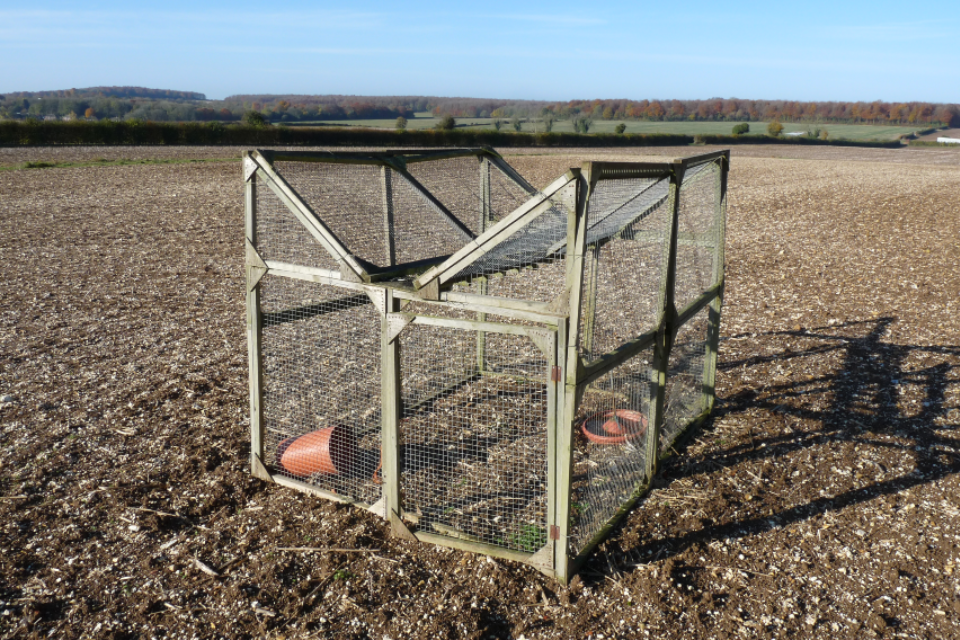
Walk in multi-catch cage trap
Larsen trap
A portable cage trap. It has a closed compartment for a live decoy bird. It has at least one capture compartment, with spring or gravity activated trap doors, which are either top or side mounted. This definition excludes traps with one or more capture compartments mounted directly above the decoy compartment.
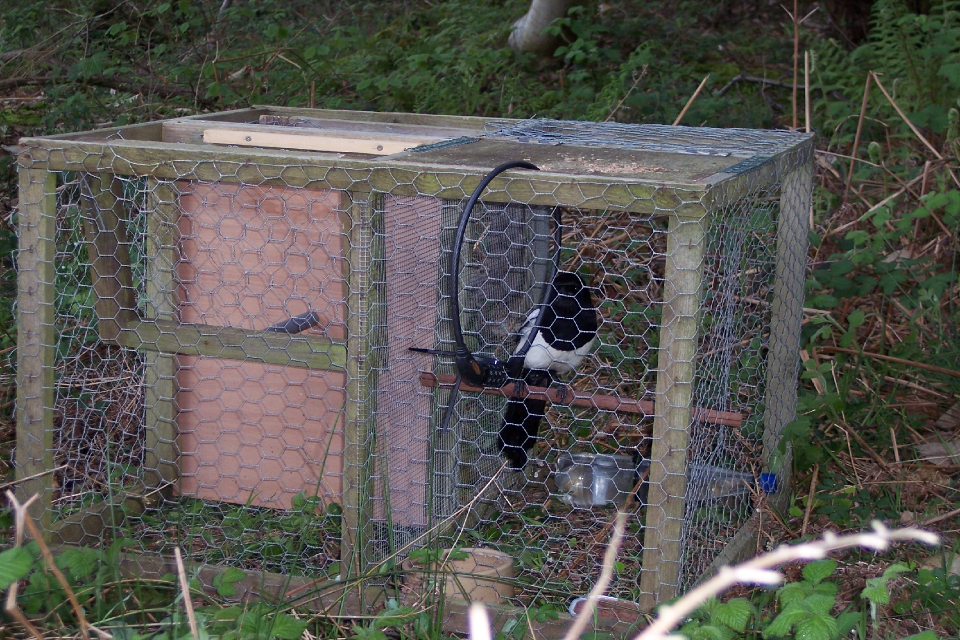
Larsen trap
Larsen mate trap
Also known as a clam trap. A portable, single-compartment, spring-operated cage trap. It comprises 2 shell sections hinged along one edge connected by one or more springs and kept open by a split-rod or trip-perch.
When open (set) the minimum distance between any 2 corners of the trap must be 39cm but not exceed the size required to humanely capture the largest target species.
The trap must not shut tightly along the majority of the length of the meeting edges, to avoid injuring the animal when it closes.
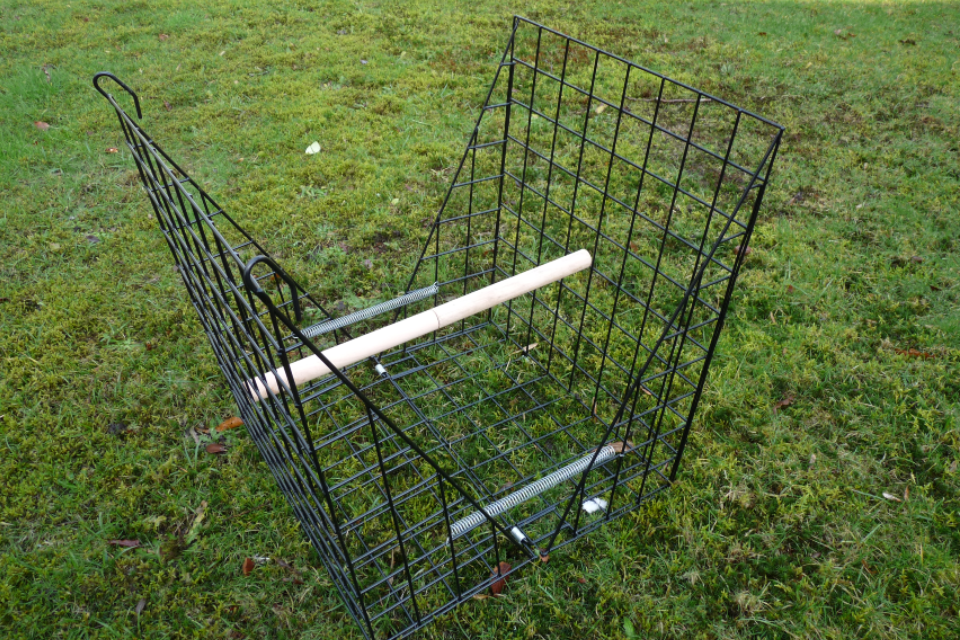
Larsen mate trap
Larsen pod trap
A portable, single compartment, spring or gravity-operated cage trap. It has either one or 2 side or top-mounted, spring-activated trap doors, which can be set independently.
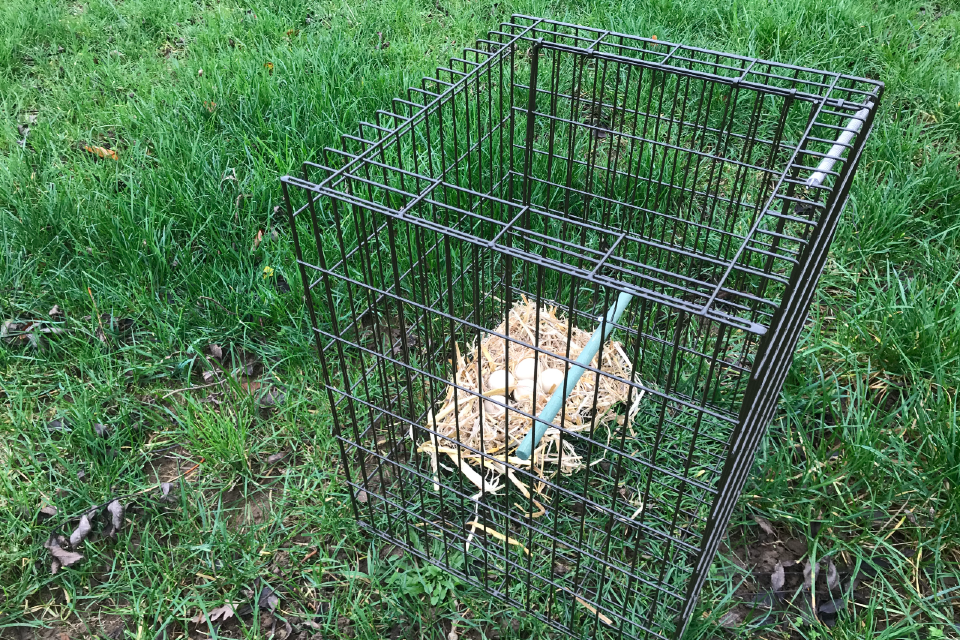
Larsen pod trap
Pigeon trap
A portable or semi-portable multi-catch trap that is covered in mesh. The birds enter the trap by walking through ‘bob wires’ (a one-way entrance) to access food that has been placed inside.
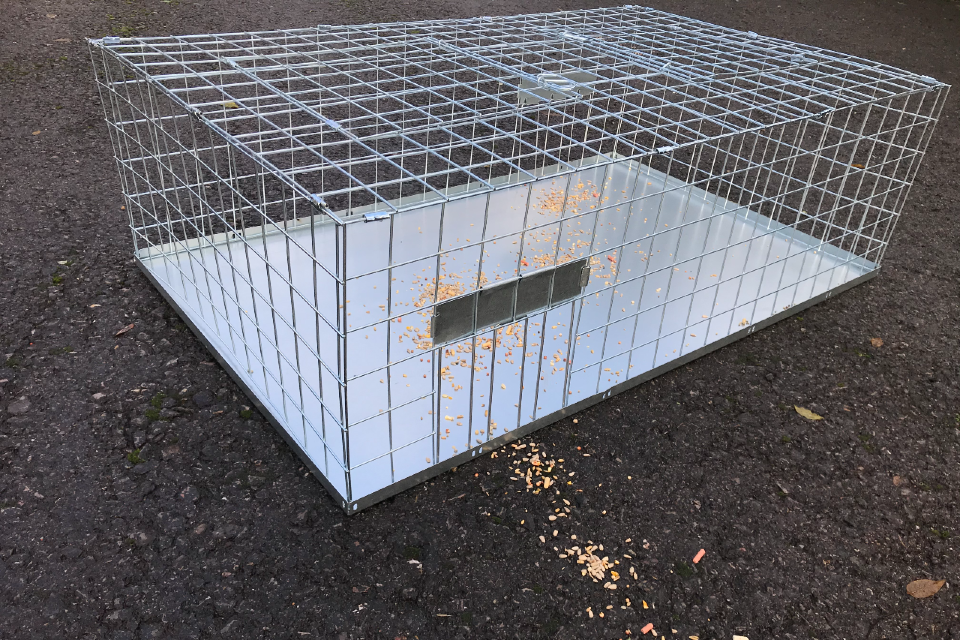
Pigeon trap
Suitable materials and components
You must use suitable materials and components to make sure the trap functions consistently and as intended. It must be suitable for use in both the:
- environment you place it in
- period of time you will use it
Suitable materials and components include wood, metal, wire or welded mesh, in a good state of repair with no sharp edges that could cause injury.
Condition 3. Where to set your trap
You must set your trap in a location that minimises the likelihood of:
- capturing non-target species
- an unauthorised person interfering with the trap
- non-target species damaging the trap, or harming themselves or trapped animals
- target species being harmed when they’re held in the trap
Advice: where to set your trap
You should avoid setting your trap in view of people using any areas they have a right of access to. If this is not possible, you could use signs to indicate it is a trap operated under a wildlife licence, to deter human interference.
You should avoid setting your trap where livestock or domestic animals are likely to interfere with it, causing injury to themselves or any animal in the trap.
You should avoid setting your trap during periods of extreme hot or cold weather, or when such conditions are likely. If extreme weather is possible, position your traps so that either natural cover or your own appropriate shelter provides trapped animals with shelter from the elements (including exposure to wind, rain, low or high temperatures).
You should avoid setting your trap in areas at risk of flooding that may harm animals held within the trap.
Condition 4. Use of meat baits
You must not use meat baits, including carrion, in any trap unless strictly necessary. This is to minimise catching non-target species.
Advice: use of meat baits
It may be strictly necessary to use meat baits:
- to catch a Corvid decoy bird when you do not have an existing decoy bird and meat is the only effective bait
- for the effective control of carrion crows, which are causing serious damage by feeding on livestock - excluding eggs
- where decoy birds or other bait types, such as eggs, are ineffective
Condition 5. Inspect your traps
When in use, traps must be physically inspected at least every 25 hours.
You must only set traps if you are confident they will be inspected within the required period. For example, if inspection every 25 hours will not be possible because of predicted severe weather, you must not set the trap.
If unforeseen circumstances mean the trap cannot be inspected, you must make every effort to have the trap inspected as soon as possible.
‘Physically inspected’ means an inspection that is sufficient to check if:
- any animal has been trapped - including the identification and physical condition of the trapped animal
- any decoy bird held within the trap is in good health
- there is food and water in sufficient quantity and condition
- the trap is operating effectively
To make a ‘sufficient’ physical inspection you need to have a clear view of all parts of the trap and its contents. This would normally require you to be close enough to touch the trap.
At each inspection, you must without unnecessary delay:
- humanely dispatch trapped target species, unless you keep them as decoys
- release, take or humanely dispatch trapped non-target species as appropriate
- remove any dead animals caught in the trap - other than food supplied for a decoy bird
- ensure that any caught bird that remains in a trap as a decoy bird has access to the facilities required for a decoy bird
You must ensure the welfare of animals caught in your trap. If an animal suffers, you may have committed an offence of causing unnecessary suffering.
Advice: inspecting traps
Ideally you should inspect traps twice a day - early in the morning and again in the evening close to sunset. This is especially important in the event of adverse weather conditions. You should first check the traps that are most exposed to the elements or to human interference.
Condition 6. Use of decoy birds
A decoy bird is a species permitted by your licence to be placed in the trap to attract other birds of the same species.
If you use decoy birds, the Animal Welfare Act 2006 requires you to ensure the welfare of the bird. This includes protecting it from pain, suffering, injury and disease.
You must provide decoys with:
You must not clip a decoy’s wings. If they escape or are released, clipped wings would make them highly susceptible to predators or attack.
Adequate food
Adequate food means palatable (and, in the case of carrion, fresh) food. It must be:
- suitable for the decoy species
- sufficient to sustain all decoy birds in the trap between inspections
- readily available to all decoy birds - other animals must not be able to deprive the decoy of it
Water at all times
The water you provide must be:
- in sufficient quantity for all decoy birds in the trap
- available and accessible to all decoy birds
- changed regularly to keep it clean and drinkable
- kept ice free during daylight hours - if this is not possible, the conditions are not suitable and you must not use a decoy bird
Appropriate shelter
You must provide decoys with shelter that provides effective protection from rain and direct sunlight under the prevailing and anticipated weather conditions.
The shelter must be sufficient for the total number of decoy birds in the trap.
What is appropriate will depend on the location of the trap and its exposure to the elements. For example, you should avoid using transparent Perspex, or other materials that would intensify heat, during warm or hot weather. You may need to use natural cover to provide additional protection.
Suitable perch
The perch must:
- not cause injury or discomfort to the feet of the decoy birds
- be long enough to host all the decoy birds in the trap
- be located within the sheltered area of the trap
Advice: food and water
Pre-soaked dried pet food can be suitable. If carrion is used for Corvid species (such as magpies and carrion crows) then it should be fresh and have enough meat on the carcass for all decoy birds.
Suitable containers to hold water include 500ml plastic drinks bottles (with the bottom half of one side cut away) turned upside down and attached to the side of the trap. This will minimise spilt or dirty water.
Condition 7. Trapped non-target species
If you trap non-target species, the requirements are different for domesticated and wild animals.
Trapped domesticated animals
If you trap a domesticated animal and it has no sign of injury, when you discover it and without undue delay, you must either:
- release it at the point of capture
- return it to its owner
If you trap a domesticated animal and it’s injured, you must take it for veterinary treatment without undue delay and if possible notify its owner.
Trapped wild non-target species
If you trap a wild non-target species, when you discover it, you must either:
- release it at the point of capture without undue delay, if it’s fit to release - unless it’s an animal that must not be released without a licence
- humanely dispatch it - unless it’s an animal that cannot be killed without a licence
If any wild animal is seriously injured, or in a condition that it would be inhumane to release, you must humanely kill it or take it for veterinary treatment.
Animals that must not be released without a licence
You must not release any animal that is not normally resident in, or a regular visitor to, Great Britain (such as a raccoon or coati).
If you catch a species listed in schedule 9 of the Wildlife and Countryside Act 1981, you must follow the rules for Part 1, Part 1A and Part 1B species.
For Part 1 species, such as Canada geese and ring-necked parakeets, you must either:
- kill the animal quickly and humanely
- have a licence to release it
For Part 1A species, such as barn owls, red kite and goshawk, you must release it as soon as you discover it, following the conditions of licence GL22.
For Part 1B species, such as wild boar, you must either:
- release the animal as soon as you discover it, at the point of capture - following the conditions of licence GL22
- kill the animal quickly and humanely
- keep the animal in captivity
- have a licence to release it at another location
If you catch a species listed as an invasive non-native (alien) animal you must not release it. You must quickly and humanely dispatch it, or give it to a premises licensed to keep it. For a list of licensed premises contact Natural England: invasive-alien-species-licence@naturalengland.org.uk
Advice: Animals that you cannot kill without a licence
Species protected against killing include wild birds, badgers, deer, species listed in schedule 5 of the Wildlife and Countryside Act 1981 and species listed in schedule 2 of the Conservation of Habitats and Species Regulations 2017.
You can only kill these species, which are caught in a legally operated trap, if:
- the animal is so seriously disabled that there is no reasonable chance of it recovering
- the animal is subject to an open season and the animal has been trapped when that open season applies
- you have a licence that permits you to kill the animal
Condition 8. Dispatch target birds humanely
You must humanely dispatch trapped target species (unless you keep them as decoys) when you discover them. You must do this without delay.
As far as is practicable, you must not dispatch birds in view of decoy birds or other trapped birds.
Advice: how to dispatch target birds
You should remove birds from the trap and dispatch using a humane method. Humane methods include a sharp blow to the back of the head using a suitable stick or dedicated priest or equivalent.
As far as is practicable, avoid the public seeing the dispatch.
Condition 9. Store traps when they are not in use
When you are not using a trap, it must not be capable of holding or catching animals.
You must:
- secure trap doors in a fully open position, or remove the doors completely from the site
- remove bait, food, water and decoys
- remove portable traps from the site where practicable, and store them in a way that prevents unauthorised or accidental use
Advice: how to store traps
Padlocks are the most secure way to secure trap doors open, but cable ties or wire may also be suitable.
If you cannot meet the conditions
If you cannot meet all of these standard licence conditions, you must not set the trap.
You may be able to use other methods of bird control, which do not need a licence.
If you cannot meet these conditions, but want to be able to trap wild birds, you must apply for an appropriate individual licence.
Avian influenza (bird flu)
Avian influenza (bird flu) is a notifiable animal disease and if you suspect any type of avian influenza in poultry or captive birds you must report it immediately by calling the Defra Rural Services Helpline on 03000 200 301. If you suspect that wild birds are affected, you should use the new online reporting system or call the Defra helpline (03459 335 577). You should refer to the latest advice on Avian influenza (bird flu) that includes further information about when dead wild birds should be reported.
Contact Natural England
Contact Natural England if you need help with these standard licence conditions.
Wildlife Licensing
Natural England
Horizon House
Deanery Road
Bristol
BS1 5AH
Email: wildlife@naturalengland.org.uk
Telephone: 0300 060 3900
